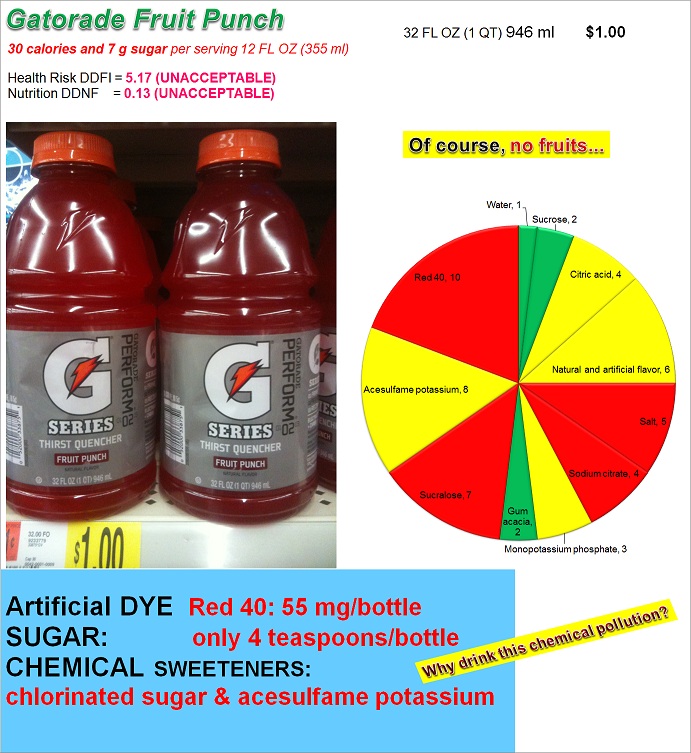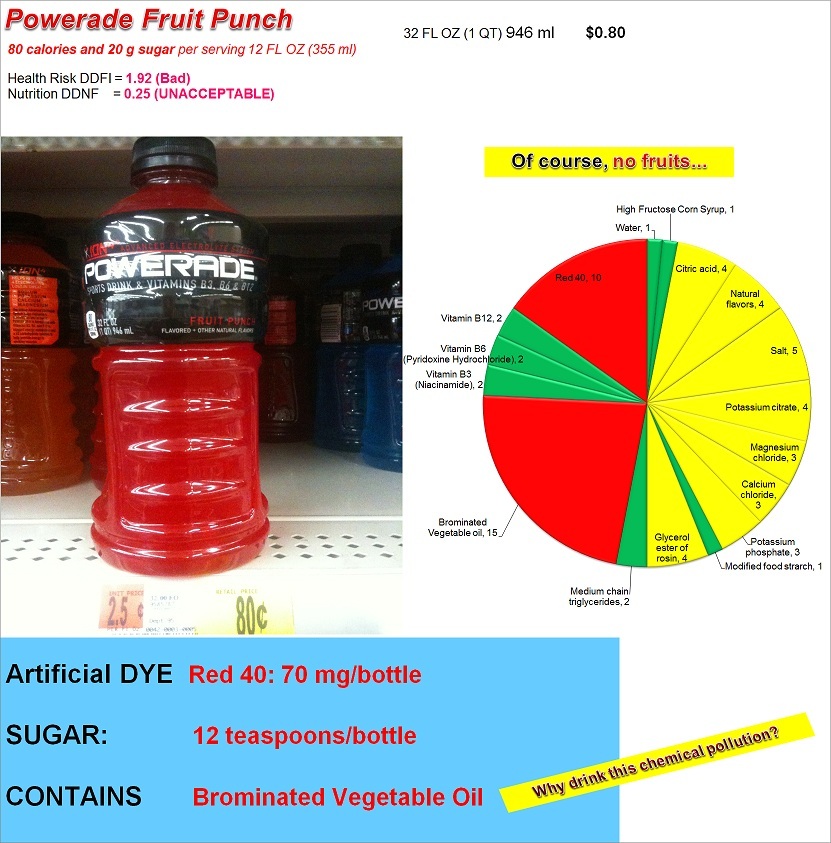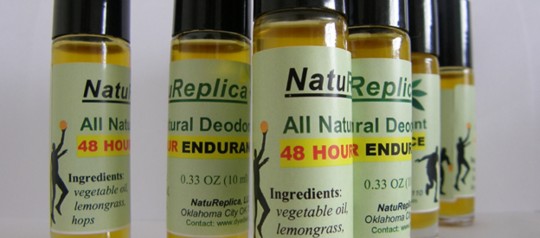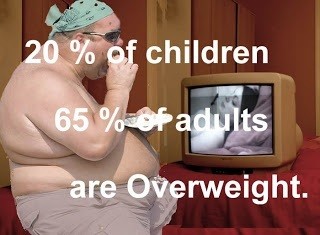Gatorade vs Powerade: Toxic sports drinks
Gatorade Fruit Punch
It is sad watching people buying and drinking Gatorade, low calorie sports drink. Why? Because they are FOOLED to believe that they buy sports drink and an electrolyte. Not only Gatorade is UNHEALTHY due to added chemicals and artificial colors but it is also a fake electrolyte! Look, potassium content is only 1% per serving of 335 ml. Hence, to get 100% of your daily potassium you are expected to drink 35 bottles of Gatorade “Fruit” Punch! Can you? However Gatorade is much higher in sodium – 7%, that means you have to dry up only 5 bottles of Gatorade. But most often sodium is NOT a problem, we consume too much of it anyway. And low caloric content is provided by two chemical sweeteners. I don’t understand how people can allow such chemically polluted water into their blood and brain…Yack…
DyeDiet Doesn’t Buy It!
Needless to say: There is NO FRUITS in the “fruit” punch. With every gulp of Gatorade “Fruit” Punch you take UNACCEPTABLY high health risk of DDFI = 5.17 and receive DANGEROUSLY low Nutritional Value of DDNF = 0.13. You should have fun calculating these numbers yourself by playing with a trial version of the Dye Diet Calculator. Simply start typing-in the ingredients, add them and then hit “Calculate!”
Food additives to avoid:
- Sucralose – chlorinated sugar, an artificial sweetener (see PDF file A Role for Sweet Taste Calorie Predictive Relations in Energy Regulation). Also read recent report The 4 Best, and 3 Worst, Sweeteners. Recent studies in man volunteers revealed that sucralose was excreted unchanged to some 97% within five days. While sucralose is recognized as “safe” not only by the FDA but also by the Center for Science in the Public Interest the DyeDiet disagrees on the general basis that, chemically, sucralose is still a chlorinated hydrocarbon that is completely foreign to human metabolism. Chlorinated nutrients are common for marine organisms like sponges, sea-weeds etc. but not for land mammals! Many chlorinated compounds are insecticidal and, most insecticides are known to be harmful for humans too. See an opinion about sucralose. Available data indicate that sucralose has low acute toxicity; oral rat LD50 ~ >10 g/kg; oral mouse LD 50 ~ >16 g/kg (see Section 11 of MSDS). OK with that! But who can swear to the public that regular consumption of sucralose for long years is safe? For instance, it was recently found that “Splenda” consumption in rats during the 12-week studies significantly lowered beneficial intestinal bacterial flora when pathogenic entero-bacteria were not affected. As always, the DyeDiet approach is: Why to take risks with our own life and the lives of our loved ones? However I realize that diabetic people may have no choice unless they want to try Stevia or other natural sugar substitutes instead.
- Acesulfame potassium – another sweetener foreign to human nature added to mask unnatural aftertaste of sucralose. According to the Wikipedia, “Acesulfame potassium has been shown to stimulate dose-dependent insulin secretion in rats, though no hypoglycemia was observed… Critics say acesulfame potassium has not been studied adequately and may be carcinogenic”
- Red 40 was DETECTED in the amount of 55 mg/bottle of Gatorade. It is an artificial color (azo dye, oxidant). See artificial dye content in other Gatorades. Recent studies showed that mixtures of Red 40 with potassium or sodium benzoate preservatives may cause hyperactive behaviour in children, that is, affect your child’s brain. Keep in mind that recommended daily intake of Vitamin A is only 1 mg.
Powerade Fruit Punch
Now let’s briefly consider Powerade “Fruit” Punch sports drink and vitamins with “Ion 4 advanced electrolyte system.” It sounds strong and formidable for mere $0.80; why not to grab it, right? Here is why not. Yes, Powerade Fruit Punch composition is a little more complicated than that of primitive “simply stupid” Gatorade, but they failed to stay away from health damaging chemicals: Brominated Vegetable Oil and Red 40 thus bringing overall the value of Powerade sports drink to nothing.
Useful food additives:
- Magnesium chloride is an electrolyte playing important biochemical role
- Calcium chloride is another important electrolyte
- Medium chain triglycerides (from coconut oil) Some studies have shown that MCTs can help in the process of excess calorie burning, and thus weight loss. Due to their ability to be absorbed rapidly by the body, medium-chain triglycerides have found use in the treatment of a variety of malabsorption ailments
- Vitamins B group . Those you can find now everywhere including baked goods, sports and soft drinks. This may pose a problem: Do we need that much Vitamins B, is it safe to consume that much? The answer is unclear.
DyeDiet Doesn’t Buy It!
Those who choose drinking Powerade instead of Gatorade will have to deal with lower but still bad health risk of DDFI = 1.92 and will receive low Nutritional Value of DDNF = 0.25. So, while the Health Risk value is 2.5 times lower and the Nutritional Value is twice higher than those of Gatorade, the both values fall into “red” range that means: Powerade Fruit Punch is NOT recommended for consumption by humans. You can play with the Dye Diet Calculator to see this for yourself to help me to further develop the calculator!
Food additives to avoid:
- Red 40 http://en.wikipedia.org/wiki/Allura_Red_AC artificial color additive was DETECTED in the amount of 70 mg/bottle of Powerade. See what is artificial dyes content in other Powerades.
- Brominated vegetable oil (BVO) is very dangerous food additive, a high density emulsifier added to help medium chain triglycerides to stay uniformly suspended in the drink. Its detrimental health effects are associated with the following:
- It mimics natural triglycerides when sneaking on-board to your body with a concealed bromine “bomb”
- When inside, after broken down with pancreatic lipase tomono-glycerides and the brominated fatty acids, toxic pieces are built into the tissue cells all over your body (including your brain!) leading to degradation of muscles, liver, kidneys, heart and brain. See attached file: Toxic Effects of Brominated Vegetabl Oils
- Slowly releases bromide to the blood stream and brain causing further CNS damage and behavioral issues
- BVO and its metabolites may cause damage of DNA and enzymes because they are capable of acting as alkylating agents.
You may want reading a recent article: Brominated oil (BVO) to be removed from Gatorade: What else should we avoid? Yes, Powerade has more reasons to be called electrolyte (because Magnesium and Calcium are present) and more reasons to be called sports drink but do not be FOOLED: Powerade is another broadly marketed unhealthy liquid. Please also note that Sodium and Potassium contents are the same as in Gatorade. In addition, there is a ridiculously lousy report from Fox News which you may find entertaining: Sports Drinks: The myths busted.
Bottom line. There is NO big difference between regular soda like Nehi, Sunkist, 7 Up Jolly Rancher, etc., and “sports’ drinks. It looks like so many people are victims of marketing tricks which falsely state that Gatorade and Powerade somehow belong to a different category of “sports drinks” and “electrolytes.” The only difference is in the number of harmful food additives and the question is: Which drink is more harmful? The right answer is: Better safe than sorry, not to drink them all. It seems we completely forgot our human nature and the more we deviate from out natural food the less human we become. This is NOT an exaggeration. This is what we are witnessing in our everyday lives: degradation. If it is not too late, let’s remember that ONLY PURE WATER is our best zero calorie sports drink. For a limited list of healthy drinks and foods, go through Dye Diet Recommended category. One of them, ONE Coconut Water is an excellent alternative. Hydrate yourself straight!
Category: American diet, Food Dyes Exposure, Food Terrorism, Sports drinks









Can you review Zevia soda? There are 15 different flavors. Some of the flavors have caramel color (natural caramel) but this is a yellow segment because the soda is made with 100% natural ingredients. I put the ingredients in the Dye Diet Calculator and there is no health risk but the nutritional value is extremely low because the diagram is mostly yellow than green. Zevia is a natural diet soda sweetened with stevia and erythritol. Even though the nutritional value is low, I recommend it if you want to satisfy any soda craving of the day. The only critical thing is that you will not get hurt. By the way, the fruity flavors (ex. grape, strawberry) are clear (not artificially dyed!). I tried this soda (grape flavor) and it tasted really good. But just remember that pure water is the healthiest 0 calorie drink.
Hey, why wouldn’t you review it? You are the most informed follower who understands details of the Dye Diet approach. I would be happy to help you with that.
As to myself, I can review anything that has ingredient list and I need at least a picture of product and a picture of the label where I can clearly see Nutrition Facts and ingredients. So far I have not came across with Zevia.
Another thing. The calculator is right because additives like Stevia and natural flavors are NOT nutrients. I can imagine there are also citric acid and sodium citrate or the like that are not nutrients neither. And that is NOT bad because ( you are right!) there are no “bad” potentially health-harmful additives. For instance, imagine pure water (green)+ citric acid (yellow). Nutritional value of such a drink will be extremely low but it is SAFE to drink in moderation and you can get your nutrients from your food. That’s the point. So the same with Zevia soda. You shouldn’t expect a soft drink to be like protein cocktail but you don’t want it to be a cocktail of chemicals like Gatorade or Kool-Aid